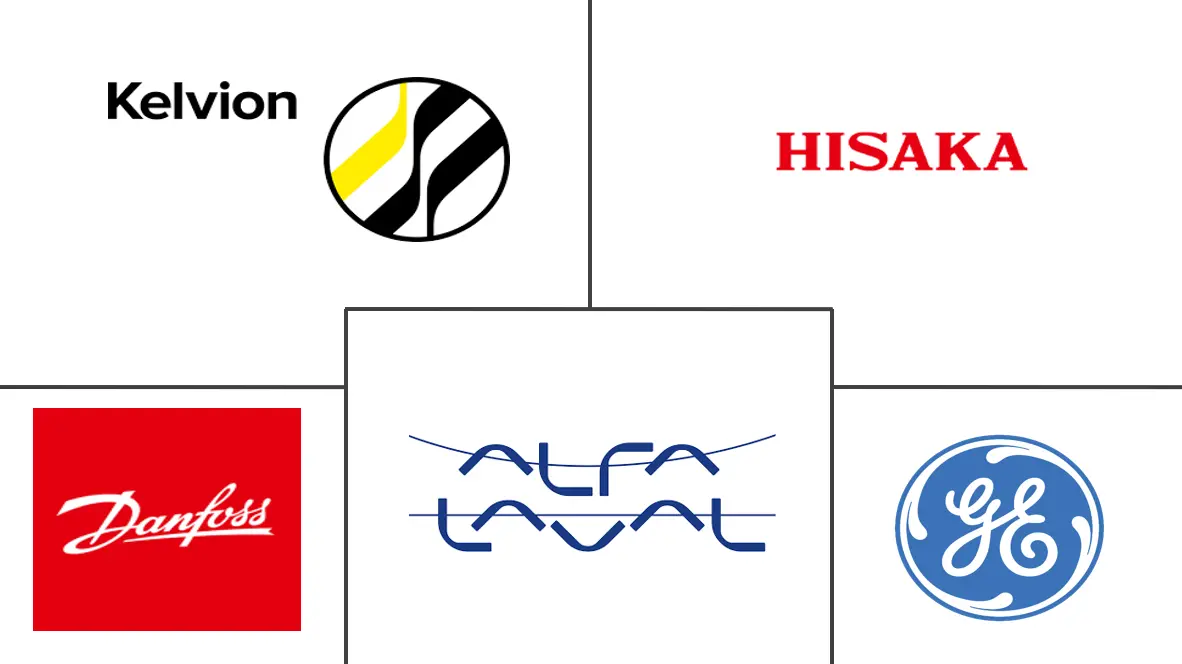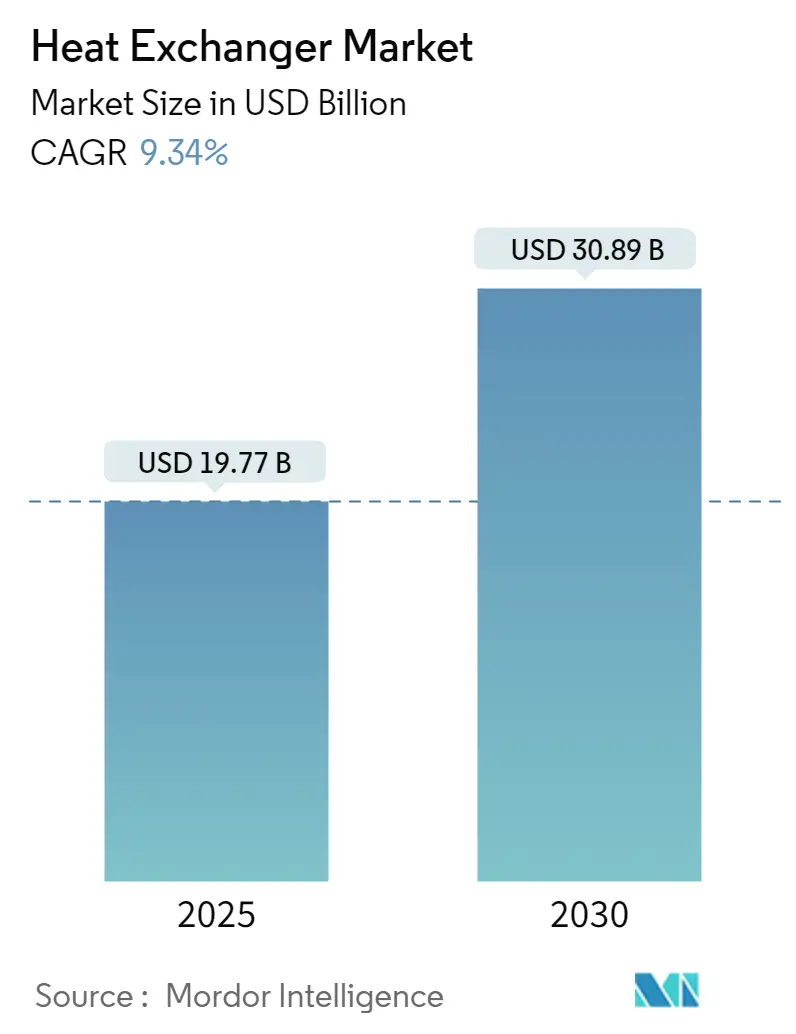
Heat Exchanger Market Analysis
The Heat Exchanger Market size is estimated at USD 19.77 billion in 2025, and is expected to reach USD 30.89 billion by 2030, at a CAGR of 9.34% during the forecast period (2025-2030).
- Over the medium term, increasing industrial applications, expansions, and the development of new power plants will likely drive the market during the forecast period.
- On the other hand, increasing renewable energy, which rarely requires a heat exchanger, is expected to impact the market negatively.
- However, increasing industrialization and urbanization in developing countries, such as China and India, require more power generation, which is expected to create an opportunity for the heat exchanger market.
- Asia-Pacific is expected to dominate the heat exchanger market due to its increasing industrial development in China, Japan, South Korea, and India.
Heat Exchanger Market Trends
Power Generation Expected to Dominate the Market
- The power generation segment is expected to dominate the market due to the increasing demand for electricity from households and industrial operations. This segment may also dominate the heat exchanger market during the forecast period.
- Heat exchangers are widely used in power generation through fossil and thermal energy. Power generation plants employ heat exchangers to collect heat from hot waste gases to generate power. The growing demand in the energy sector may boost the heat exchanger market during the forecast period.
- According to the Energy Information Administration, the total electricity generation in the United States accounted for 4,178 terawatt-hours (TWh) in 2023. Compared to the previous year, power generation decreased by 50 TWh, but with increasing urbanization, the electricity demand is expected to grow further in the coming years.
- In a nuclear power plant, heat exchangers transfer heat from the primary side (reactor) to the secondary side steam generator. In April 2024, the United Arab Emirates announced that it would release a tender for constructing a new nuclear power plant that would double the small Gulf state's nuclear reactors. Such projects will boost the demand for heat exchangers in the power sector.
- Hence, such projects will positively impact the heat exchanger market during the forecast period.
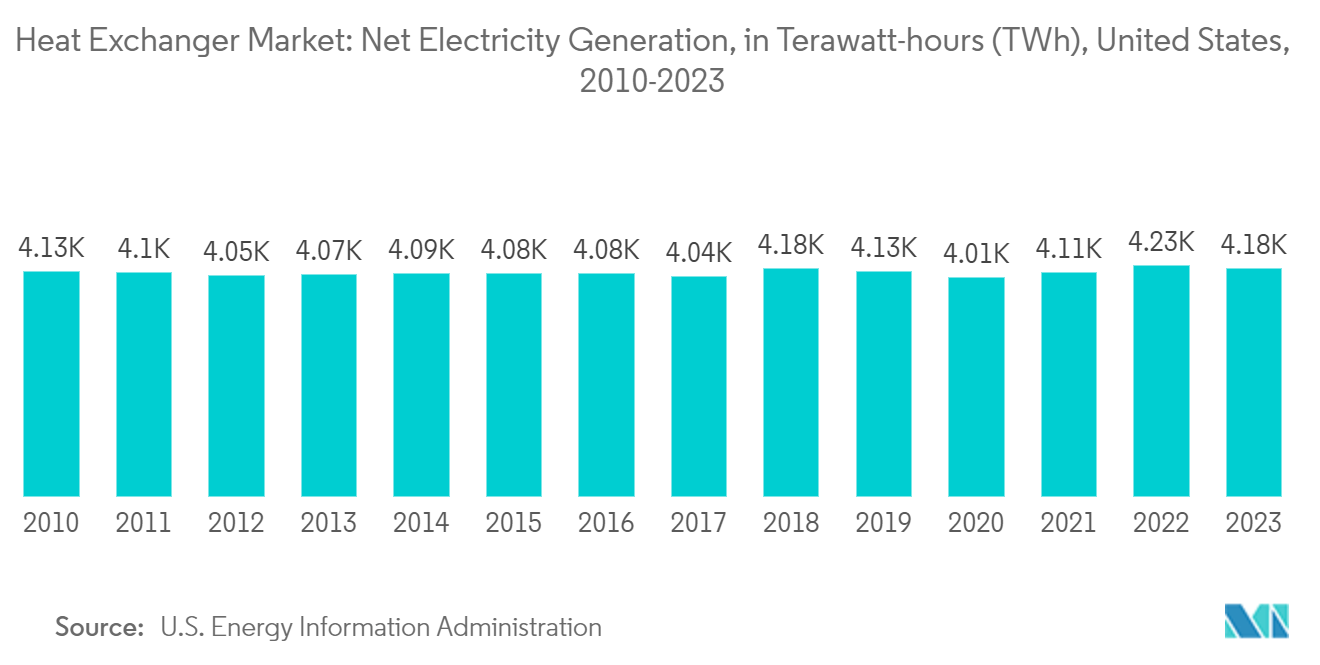
Asia-Pacific Expected to Dominate the Market
- Asia-Pacific dominated the heat exchanger market in the past. It will likely dominate the market during the forecast period due to several power projects under construction.
- As of July 2023, China had 1,142 operational coal power plants, and the government plans to include more large-scale coal-fired power plants. This factor is expected to drive the country's demand for heat exchangers.
- Several heat exchanger companies are investing to expand their regional presence, which is expected to drive the market. In June 2023, LU-VE Group, the world’s largest operator in the field of air heat exchangers, agreed with Tianmen Prefecture (Hubei Province, China) to expand the LU-VE Tianmen production plant.
- Additionally, NTPC Ltd intends to begin the construction of additional coal plants this year. The country continues to rely on fuel to meet its expanding energy needs. The New Delhi-based NTPC is expected to award building contracts for approximately 4.5 gigatonnes of coal-fired capacity.
- Further, in the upcoming period, the market for heat exchangers will be in demand as countries like India and China focus on building new nuclear power plants. For example, in May 2023, Nuclear Power Corporation of India Ltd agreed to develop six 700 MW pressurized heavy water reactors (PHWRs) across two sites in India.
- Hence, such projects are expected to drive the Asia-Pacific heat exchanger market during the forecast period.
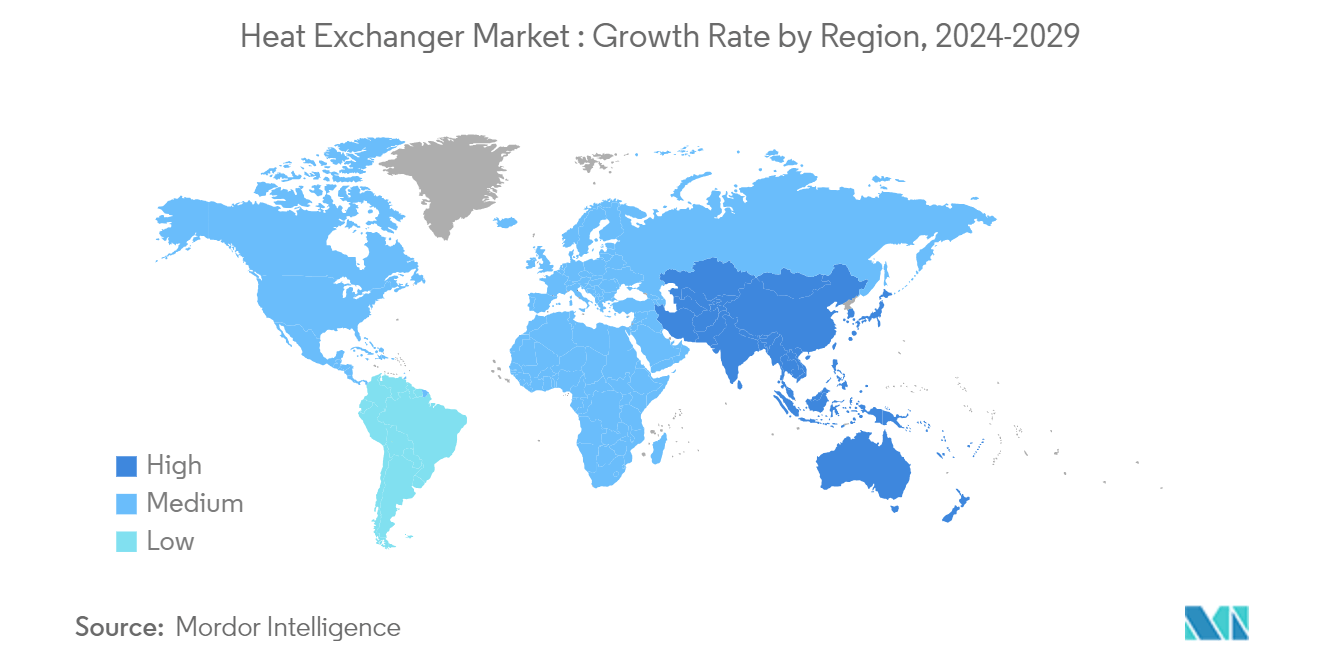
Heat Exchanger Industry Overview
The heat exchanger market is moderately fragmented. The key players in the market include (in no particular order) Alfa Laval AB, Danfoss AS, General Electric Company, Hisaka Works Ltd, and Kelvion Holding GmbH.
Heat Exchanger Market Leaders
-
General Electric Company
-
Alfa Laval AB
-
Kelvion Holding GmbH
-
Danfoss AS
-
Hisaka Works Ltd
- *Disclaimer: Major Players sorted in no particular order
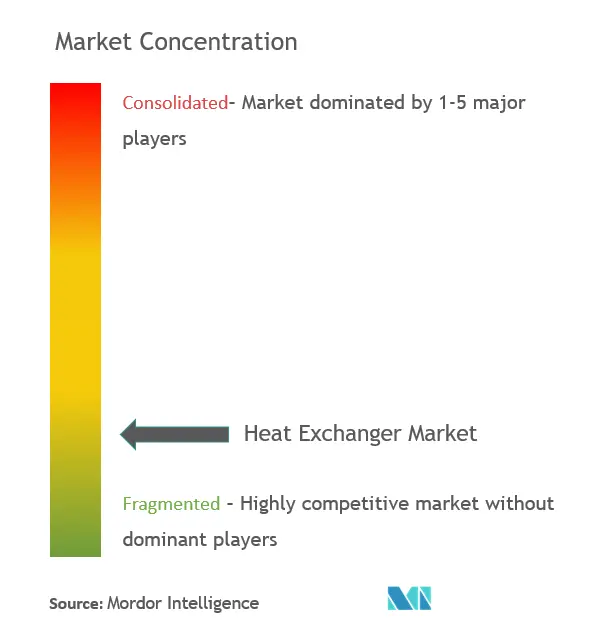
Heat Exchanger Market News
- September 2023: APV, a part of SPX FLOW’s suite of process solutions, introduced the new Plate Heat Exchanger FastFrame. The product has improved usability and durability, which is expected to save time and money for food and beverage operators.
- April 2023: Researchers in India developed a PV-powered earth-to-air heat exchanger to provide space heating and cooling in buildings. According to them, the proposed system may generate an annual energy gain of 8116.7 kWh.
- March 2023: Alfa Laval launched AlfaNova GL50. The company claims the product is the first heat exchanger explicitly developed for fuel cell systems.
Heat Exchanger Industry Segmentation
Heat exchangers are devices that transfer heat from one medium to another. These media can be either a gas, a liquid, or a combination of the two. To prevent mixing, the media may be separated by a solid wall or in direct contact. Heat exchangers must supply heating and cooling to meet a process's needs.
The heat exchanger market is segmented by construction type, end user, and geography. By construction type, the market is segmented into shell and tube, plate frame, and other construction types. By end user, the market is segmented into the oil and gas industry, power generation, chemical, food and beverages, and other end users. The report also covers the market size and forecasts for the heat exchanger market across major regions such as North America, Europe, Asia-Pacific, South America, and the Middle East and Africa. For each segment, the market sizing and forecasts are done based on revenue (USD).
| Construction Type | Shell and Tube | ||
| Plate Frame | |||
| Other Construction Types | |||
| End User | Oil and Gas Industry | ||
| Power Generation | |||
| Chemical | |||
| Food and Beverages | |||
| Other End Users | |||
| Geography | North America | United States | |
| Canada | |||
| Mexico | |||
| Rest of North America | |||
| Europe | United Kingdom | ||
| Germany | |||
| France | |||
| Russia | |||
| NORDIC | |||
| Italy | |||
| Spain | |||
| Rest of Europe | |||
| Asia-Pacific | India | ||
| China | |||
| Japan | |||
| Australia | |||
| Thailand | |||
| Indonesia | |||
| Malaysia | |||
| Rest of Asia-Pacific | |||
| South America | Brazil | ||
| Argentina | |||
| Colombia | |||
| Rest of South America | |||
| Middle East and Africa | United Arab Emirates | ||
| Saudi Arabia | |||
| Qatar | |||
| Nigeria | |||
| South Africa | |||
| Egypt | |||
| Rest of the Middle East and Africa | |||
Heat Exchanger Market Research FAQs
How big is the Heat Exchanger Market?
The Heat Exchanger Market size is expected to reach USD 19.77 billion in 2025 and grow at a CAGR of 9.34% to reach USD 30.89 billion by 2030.
What is the current Heat Exchanger Market size?
In 2025, the Heat Exchanger Market size is expected to reach USD 19.77 billion.
Who are the key players in Heat Exchanger Market?
General Electric Company, Alfa Laval AB, Kelvion Holding GmbH, Danfoss AS and Hisaka Works Ltd are the major companies operating in the Heat Exchanger Market.
Which is the fastest growing region in Heat Exchanger Market?
Asia Pacific is estimated to grow at the highest CAGR over the forecast period (2025-2030).
Which region has the biggest share in Heat Exchanger Market?
In 2025, the Asia Pacific accounts for the largest market share in Heat Exchanger Market.
What years does this Heat Exchanger Market cover, and what was the market size in 2024?
In 2024, the Heat Exchanger Market size was estimated at USD 17.92 billion. The report covers the Heat Exchanger Market historical market size for years: 2020, 2021, 2022, 2023 and 2024. The report also forecasts the Heat Exchanger Market size for years: 2025, 2026, 2027, 2028, 2029 and 2030.
Our Best Selling Reports
Heat Exchanger Industry Report
The global heat exchangers market is experiencing robust growth, driven by increasing demand across various industries for sustainable, energy-efficient, and cost-effective thermal management solutions. Key market segments include chemical processing, power generation, HVAC systems, and oil and gas industries, which utilize heat exchangers for efficient heat transfer and energy conservation. The market benefits from technological advancements enhancing performance and efficiency. Regionally, Asia Pacific leads with rapid industrialization in countries like China and India. Market dynamics are shaped by factors such as the rising number of nuclear power plants, stringent environmental regulations, and a global push towards energy efficiency. Challenges include the capital-intensive nature of the industry and lack of awareness about energy-efficient buildings. Despite these challenges, the market is set to continue its expansion, supported by innovation and increasing applications in emerging economies.
The market report covers global market growth and trends, offering detailed market size analysis and market growth insights. Market research indicates a positive market share outlook, supported by industry report data and market forecast predictions. The global market overview highlights industry trends and market segmentation, providing valuable market data and industry statistics. Industry analysis reveals a significant growth rate, driven by market leaders and industry sales in various sectors.
The market outlook remains optimistic, with market value projections and market review reports indicating continued growth. Industry information and industry research provide a comprehensive understanding of market dynamics, with market predictions suggesting sustained industry size expansion. Report examples and report PDFs offer in-depth industry reports, detailing market segmentation and market value trends. Research companies contribute to the market analysis, ensuring accurate and up-to-date industry outlook and market forecast data.

